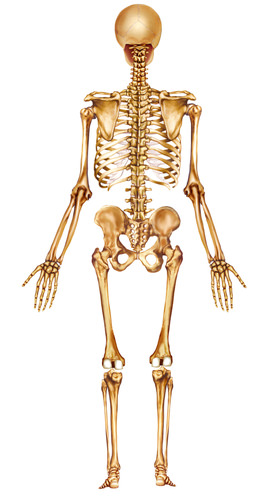4.5: Evolution Evidence
- Page ID
- 3023

Why do you have a tail bone?
If you look closely at a skeleton, you might notice a triangular bone at the end of the spinal column. This is your tailbone. Why would you have a tailbone when you don't have a tail? You have a tailbone because your ancient ancestors did have a tail. These sorts of "left-over" structures support the theory of evolution.
Structural Evidence
Even though two different species may not look similar, they may have similar internal structures that suggest they have a common ancestor. That means both evolved from the same ancestor organism a long time ago. Common ancestry can also be determined by looking at the structure of the organism as it first develops.
Vestigial Structures
Some of the most interesting kinds of evidence for evolution are body parts that have lost their use through evolution (Figure below). For example, most birds need their wings to fly. But the wings of an ostrich have lost their original use. Structures that have lost their use through evolution are called vestigial structures. They provide evidence for evolution because they suggest that an organism changed from using the structure to not using the structure, or using it for a different purpose.
Penguins do not use their wings, known as flippers, to fly in the air. However, they do use them to move in the water. The theory of evolution suggests that penguins evolved to use their wings for a different purpose. A whale’s pelvic bones, which were once attached to legs, are also vestigial structures. Whales are descended from land-dwelling ancestors that had legs.
Homologous structures are structures that have a common function and suggest common ancestry. For example, homologous structures include the limbs of mammals, such as bats, lions, whales, and humans, which all have a common ancestor. Different mammals may use their limbs for walking, running, swimming or flying. The method the mammal uses to move is considered a common function.

Similar Embryos
Some of the oldest evidence of evolution comes from embryology, the study of how organisms develop. An embryo is an animal or plant in its earliest stages of development. This means looking at a plant or animal before it is born or hatched. Centuries ago, people recognized that the embryos of many different species have similar appearances. The embryos of some species are even difficult to tell apart. Many of these animals do not differ much in appearance until they develop further.
Some unexpected traits can appear in animal embryos. For example, all vertebrate embryos have "gill slits" which are not actually gills. They connect the throat to the outside early in development but eventually close in many species; only in fish and larval amphibians do they contribute to the development of gills. In mammals, the tissue between the first gill slits forms part of the lower jaw and the bones of the inner ear.
The similarities between embryos suggests that these animals are related and have common ancestors. For example, humans did not evolve from chimpanzees. But the similarities between the embryos of both species suggest that we have an ancestor in common with chimpanzees. As our common ancestor evolved, humans and chimpanzees went down different evolutionary paths and developed different traits.
Summary
- Vestigial structures, or structures that have lost their use through evolution, are important evidence of evolution.
- Studying the embryos of organisms also provides evidence that two very different animals could have descended from a common ancestor.
Review
- What is a vestigial structure? Give an example.
- How does embryology provide evidence for evolution?
- Given an example of a structure that is present in human embryos, but has disappeared by birth.

